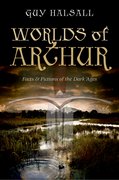Worlds of Arthur : Facts and Fictions of the Dark Ages
376 pages
|
20 black and white halftones, 15 maps
|
234x156mm 978-0-19-965817-6
|
Hardback
|
February 2013 (estimated)
Description
Author Information
| Guy Halsall,
Professor of History, University of York
Guy
Halsall has taught at the universities of London and York, where he has
been a professor of history since 2003. His early specialism was in the
history and archaeology of the Merovingian period (c.450-c.750), and he
has since published widely on a broad range of subjects: death and
burial, age and gender, violence and warfare, barbarian migrations, and
humour. This investigation into the 'worlds of Arthur' brings him back
to the study of early medieval British history and archaeology with
which his scholarly training began.
|
Reviews
| "Written by our leading authority on Early Medieval Warfare this sweeping synthesis cuts through all the fantasy Arthuriana to the chaotic reality of the tumultuous years after the end of Roman Britain. With a fresh and incisive look at all the key sources, and a masterly and imaginative use of the archaeological evidence, Guy Halsall offers nothing less than a rethinking of what happened at the time of the Anglo-Saxon migrations. Readable, authoritative, and witty, this is an ambitious and wide ranging synthesis which will appeal to all who are interested in the history behind one of the world's greatest collections of myths and stories, vividly recreating the fractured world out of which medieval Britain emerged. And while some may regret the loss of the Hollywood Arthur, Halsall shows us that behind that image is a reality which is no less fascinating." - Michael Wood, historian, broadcaster and author of In Search of the Dark Ages |
Table of Contents
1: The Story of 'King Arthur'
2: The Matter of Arthur: the Traditional Narrative
3: Swords in the Stones: the Archaeology of Post-Imperial Britain
4: The Antimatter of Arthur: Reassessing the Written Sources
5: Continuity or Collapse? The End of Roman Britain
6: Beyond Brooches and Brochs: Rethinking Early Medieval British Archaeology
7: Red Herrings and Old Chestnuts
8: The Matter of Arthur: Changing the Framework
9: Rethinking the Anglo-Saxon Migration and Setttlement (1): When Did the Anglo-Saxons Come to Britain?
10: Rethinking the Anglo-Saxon Migration and Setttlement (2): The Nature and Scale of the Migration
11: Fifth and Sixth Century Politics in Britannia
12: The End of the 'World of Arthur'
Further Reading
Index



